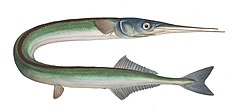Garfish
| Garfish | |
|---|---|
 |
|
 |
|
| Scientific classification | |
| Kingdom: | Animalia |
| Phylum: | Chordata |
| Class: | Actinopterygii |
| Order: | Beloniformes |
| Family: | Belonidae |
| Genus: | Belone |
| Species: | B. belone |
| Binomial name | |
|
Belone belone (Linnaeus, 1761) |
|
 |
|
| The range of the garfish | |
| Synonyms | |
|
|
The garfish (Belone belone), or sea needle, is a pelagic, oceanodromous needlefish found in brackish and marine waters of the Atlantic, the Mediterranean Sea, Caribbean Sea and the Baltic Sea.
The garfish is a long and slender fish with a laterally-compressed body, and grows to about 50 to 75 centimetres (20 to 30 in) in length. The jaws are elongated and armed with sharp teeth. The pectoral, dorsal and anal fins are situated well back on the body and the latter two are similar in appearance. Positioning the fins so far back gives greater flexibility to the body. The lateral line is set low on the flanks. The colour of the body is bluish green with a silvery grey belly and the bones are green.
Garfish are pelagic fish which live close to the water surface. They eat small fish and have a migratory pattern similar to that of the mackerel, arriving a short time before the latter to spawn. They move into shallow waters in April and May and spawn in areas with eelgrass in May and June. In the autumn they return to the open sea, including the Atlantic west of the British Isles. Garfish are oviparous and the eggs are often found attached to objects in the water by tendrils on the egg's surface.
The garfish is a predator which hunts in the open sea seeking out shoals of small fish such as Atlantic herring, sprats, sand eels and even three-spined sticklebacks. They also feed on free-swimming crustaceans.
Garfish are sometimes caught as bycatch, mainly in fixed nets along the coast in shallow waters. If caught with rod and line they tend to leap out of the water when hooked. Garfish are eaten boiled, fried, baked, barbecued or smoked. They have unusual green bones (due to the presence of biliverdin) which discourages many people from eating them, but the green colour is harmless.
...
Wikipedia
